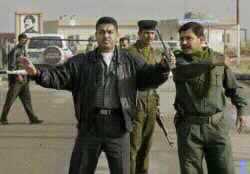- Author:
& News Agencies - Section:
WORLD HEADLINES
- Hajj & Umra WORLD HEADLINES
U.S., U.N. Analyze Huge Iraqi Arms Declaration

U.S. and U.N. experts began analyzing on Tuesday Iraq's mammoth arms declaration that contains detailed information about efforts to build a nuclear bomb, research on biological warfare and what could be an embarrassing list of suppliers for its illegal weapons. A nine-page table of contents was released to U.N. Security Council members on Monday. Much of the information appeared to repeat data on weapons of mass destruction that had been submitted to the United Nations since the 1991 Gulf War .
"Nothing immediately struck us as new in the lot," said .
said Gary Milhollin, director of the Wisconsin Project on Nuclear Arms Control, a Washington research group.
But he said "this is a giant piece of information that is going to take quite some time to analyze."
In a controversial move, the United States obtained one of two copies delivered to U.N. headquarters on Sunday, duplicated it quickly, and then shared it with the other four permanent Security Council members. Britain and France received their copy in Washington on Monday while Russia and China asked for it to be flown back to New York, diplomats said.
The other 10 rotating council members will get only an edited copy, possibly in a week, with sensitive portions that could contain recipes for making dangerous weapons excised by the U.N. Monitoring, Verification and Inspection Commission, known as UNMOVIC.
Its executive chairman, Hans Blix, is expected to tell council members on Tuesday how long this process will take. He has assigned the document to 15 experts in an analysis and assessment unit, headed by a former French military officer and chemical weapons specialist, Jean-Louis Roland.
EXPERTS GATHER IN WASHINGTON
In Washington, experts gathered at a central place and then expected to divide up sections of the nearly 12,000 page document that details Iraq's weapons efforts and items with civilian as well as military uses as required under a Nov. 8 Security Council resolution.
Security Council members on Friday had decided everyone should received the purged report, a move that apparently angered the United States.
After a flurry of phone calls over the weekend, all but Syria agreed to the arrangement to allow the five powers to receive the document immediately. Mexico, which had also objected, relented after Secretary of State Colin Powell telephoned Foreign Minister Jorge Castanega.
Several council members, however, have told the United States that none of the excised material should be a basis for a "material breach" -- words that could allow war -- because they would have no way of judging its veracity.
While the United States says it can declare a material breach, the other 14 council members, including close ally Britain, say the Nov. 8 resolution requires violations to be verified by U.N. arms inspection commissions.
The White House, however, was low-keyed on Monday.
"The analysis of this document is going to be done in a very thoughtful, thorough and complete way," spokesman Ari Fleischer said. "We want to be very deliberative as we move through and look at this document to determine, with the international community, what this indicates about Saddam Hussein and his disarmament."
The table of contents includes many presentations Baghdad made to U.N. inspectors before they withdrew in 1998.
Most of the nuclear program appeared to be a duplicate of earlier documents, according to the chapter headings in the index. But about 300 pages cover "the period from 1991 to 2002" and describe Iraq's Atomic Energy Organization.
Also mentioned are drones as well as a "terminated radiation bomb," program, which Iraq declared to the inspectors in 1996.
The bomb, tested in 1987, was designed to cause cancer, birth defects and slow death but the experiment did not work.
The ballistic missile section also brings its activities up to 2002 and promises procurement details with "states, companies, establishments and main suppliers."
Under biological weapons, for example, 33 pages were devoted to "acquisition of equipment, material, supplies and empty munitions containers for all phases of the program."
"If they have listed all their suppliers, that is quite important and should be made public," Milhollin said in an interview. "If you expose this network, it means it is harder for them to continue."
Information of arms suppliers in the past has been submitted by Iraq but not disclosed by the United Nations.
Companies around the world that gave the data did so on condition they not be identified publicly. Unknown is whether the United States and other council members will try to suppress this part of declaration also.
PHOTO CAPTION
Iraqi security officials prevent journalists from entering a military industrial complex, the Al-Tariq General Company, northwest of Baghdad and near the town of Fallujah December 9, 2002 where weapons inspectors from the U.N. Monitoring, Verification and Inspection Commission carried out a search. Under a quiet deal struck over the weekend, the United States received an early and uncut copy of Iraq's weapons declaration and whisked it to Washington for analysis, diplomats and U.S. officials said. (Suhaib Salem/Reuter
Related Articles
 Hajj virtues
Hajj virtues
-
School of Faith in Ten Days of Thul-Hijjah
The believing human self needs strong provocations in order to awaken whenever it is enveloped by laziness in...
-
The Status of Hajj in Islam
Hajj is the fifth pillar of Islam; Allah, The Exalted, ordained it in the ninth year after Hijrah (the Prophet's,...
-
School of Faith in Ten Days of Thul-Hijjah
The believing human self needs strong provocations in order to awaken whenever it is enveloped by laziness in relation...


 Home
Home Discover Islam
Discover Islam Quran Recitations
Quran Recitations Lectures
Lectures
 Fatwa
Fatwa Articles
Articles Fiqh
Fiqh E-Books
E-Books Boys & Girls
Boys & Girls  Hajj Rulings
Hajj Rulings Hajj Fatwas
Hajj Fatwas












